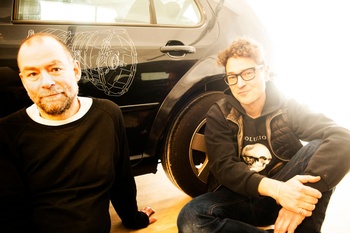The MIMA's ninth exhibition, “Verisimilitude”, is a fascinating collaboration between Félix Luque Sánchez, Damien Gernay, and Iñigo Bilbao Lopategui. Their cross between pessimistic science fiction and a reflection on technical objects stirs up our deepest fears. Sánchez: “What interests me is the totally schizophrenic relationship that we have with technology.”
© Ivan Put
| 'Bois Mort', a lo-fi installation made up of randomly flashing neon lights, is at the centre of the dystopian chapel.
For its ninth exhibition, the MIMA (Millennium Iconoclast Museum of Art) has chosen to present a complex framework, a sort of movement backwards and forwards through the corridors of time that plunges visitors into troubled waters, forcing them to think, beyond the pandemic, about the uncertainty that permeates our choices as a civilisation. “It is a rendering of a future world viewing a past that is, in reality…our present,” says Raphaël Cruyt, the artistic director of the event. “Our present is imagined as a remnant. We examine what that trace says about us.”
The title “Verisimilitude” suggests an anxiety-inducing post-capitalist vision of the future of the kind that haunts a society that is collapsing. Created by Félix Luque Sánchez (Oviedo, 1976), in collaboration with the designer Damien Gernay (born in the Parisian suburbs in 1975) and Iñigo Bilbao Lopategui (Oviedo, 1975), the project is very apposite in the context of a slowed-down “less optimistic, more anxious, and less active” world.
Straight away, an enlightening parallel emerges with Frankenstein by the British Romantic author Mary Shelley, who also crystallised the nightmares of an age. “We know that, when she wrote Frankenstein in 1816, Shelley knew of several experiments using electricity,” explains Cruyt. “First, there was Galvani, who induced muscular contractions in dead frogs by passing a current through their feet but there was also, even more shockingly, his nephew, Giovanni Aldini, who succeeded in making the face of a man, George Foster, who had been hung for the murder of his wife, convulse in front of an audience of scientists from the Royal Humane Society. It was a small step from that to thinking that electricity could revive the dead. There is a reason that the British author imagined Frankenstein as a horrifying being: it says everything about the ambiguity of the technological progress that the use of the electric current represented. Humankind begins to fear the power that lies in its hands, which creates an ambivalent attitude, somewhere between fear and fascination.”
Our intention is to confront visitors with the contradictions they formulate about a technical object: that they expect it to save them and, at the same time, see it as causing humanity's ruin
Another reason for making a connection between the present time and the first twenty years of the nineteenth century lies in the fact that those two decades were a time of great climatic change, a “little ice age” that resulted in dark skies, which can even be seen in paintings, such as Turner's work or the famous painting by Antoine-Jean Gros showing the battle of Eylau. Different time, same twilight, art assimilates these upheavals and helps us to think about them.
But this time round, the human being is no longer at the centre. In Félix Luque Sánchez's work, humans seem to have disappeared from circulation. In their place are the technical objects, which are animated, as if they have now acquired a life of their own, thus rekindling all the fears relating to the dispossession of the real caused by artificial intelligence. The exhibition takes a particularly dim view of the car, which we see in the form of a wreck or detached parts.
“The car is a symbol of capitalism and mass consumption,” says Luque Sánchez, who began to make sculptures in 2007, after studying digital art in Barcelona and working in universities. “A symbol of modernity since the second half of the nineteenth century, today the car raises questions about the major challenges facing the contemporary world: the depletion of natural resources and environmental collapse. The car industry exemplifies the current fragility of the neoliberal model and economic globalisation. It has become a symbol of the incapacity of current technological alternatives to meet those challenges.”
END OF MANKIND
“Verisimilitude” opens with a screening of a short film that draws you in. It is played on a loop and accompanied by a soundtrack by Le Motel. This is an exhibition that you do not just look at; it also has to be heard. In six minutes, Junkyard III (2019) establishes a setting that is familiar but…destroyed. It follows three characters, two women and a man, all alone in the world, who wander through this fearsome post-catastrophic space-time. The trio pass deserted roads and abandoned villas, performing acts of survival (such as carving up a rat) and exploring technical objects that have become obsolete.
The piece, commissioned from the film-maker Nicolas Torres Correia, functions as a decompression chamber for dealing with the shock of the time frames and paradigms presented by Félix Luque Sánchez. It also provides the keys to the formal devices that will be employed over the course of the exhibition. A word of advice: memorise the silhouettes of the actors in this short film because there is not a single other human figure in the exhibition. In a way that is very revealing, the expressions on faces give way to mechatronic sculptures and algorithmic processes.
“In this exhibition, it is important to understand that we are creating a fiction out of very real territories that we re-materialise,” says Luque Sánchez. “This recreation establishes a distance between reality and its representation in the exhibition space. That back-and-forth defines our work. The intention is to confront visitors with the contradictions they formulate about a technical object: that they expect it to save them and, at the same time, see it as causing humanity's ruin. What interests me is the totally schizophrenic relationship that we have with technology.”
On the first floor, you come face to face with the shells of two cars, shrouded in a darkness that is pierced only by thin rays of light. The sombre atmosphere sets the general tone for “Verisimilitude”. Only the last floor escapes the unsettling obscurity. Beside the cars is a robot that tattoos technical drawings straight onto their bodywork. Faced with these symbols of a cult yet to be invented, you might ask yourself if this is a new kind of cave art.

© Ivan Put
| Felix Luque Sánchez (right) and his collaborator, designer Damien Gernay. "The car industry has become a symbol of the incapacity of current technological alternatives to meet the challenges ahead."
A little further on, you come across the ghostly Junkyard I (2019). In this projection of 3D scans by Iñigo Bilbao Lopategui, which functions the same way as a point cloud, the body of a car appears, traveling slowly, hypnotically across a screen. The extremely precise aesthetic that is employed is truly fascinating. It is like a new kind of landscape painting that, despite being created by technological means, is highly reminiscent of the style of the neo-Gothic world of the US illustrator Bernie Wrightson.
The first level also contains a series of sculptures made from embossed car body parts or motorway signs arranged in three dimensions to form a crown of wires with Christ-like undertones. “The pieces are mixed; some are made using digital technology, others are created manually. The sheets of metal are cut by laser, but the embossing was done by hand,” explains the creator, who identifies more with the label “plastic artist” than “digital artist”, even though all the work on display references current technology, either in terms of form or content. It all evokes the symbols of a world that has been engulfed, at least in the scenario created by the Spanish artist, now in his forties, who has lived in Brussels since his adolescence.
CLIMAX
The further you progress through the exhibition, the more insignificant humanity seems. The human view of things is replaced by the eye of a technology that contemplates the world or, with unexpected narcissism, views itself.
On the second floor, shockingly, the brightest room in the MIMA, in which most artists use the light to enhance their work, is in total darkness. A chilling new approach, it transforms the space into a dystopian chapel. At the centre is Bois Mort (2015), a lo-fi installation made up of randomly flashing neon lights and an inextricable network of exposed electric wires. Stripped of their modesty, they reveal their technological innards. This epileptic image of a synthetic forest, accompanied by an electrifying sound score, makes a profound impression. The piece is hostile. Surrounded by transformers, it creates a sense of unease: the visitor cannot look at it for too long. As it happens, the piece is part of the very personal Memory Lane series, which revisits significant places from Félix Luque Sánchez's childhood, in this case, a forest in Asturias in which he used to play. This series of pieces about memories brings an obvious reference to mind: “rosebud” in Citizen Kane, which is also the key to a mystery that is, ultimately, existential.
Humankind begins to fear the power that lies in its hands. That creates an ambivalent attitude, somewhere between fear and fascination
On the top floor, the climactic final piece is the only one to be lit by daylight. Luque Sánchez explains Perpétuité (2020), a genuine contemplative experience created using technical objects whose primary function has been altered: “It consists of two machines that interact in such a way as to neutralise one another. The first attempts to draw the infinity symbol with sand and, when it has nearly completed it, the second begins to erase the drawing from the beginning.” A sort of never-ending high-speed chase that transposes the legend of Sisyphus to the field of robotics.
Leaving “Verisimilitude” you might well be inspired to reread Gilbert Simondon, the French philosopher who, in a prophetic manner, pointed out the danger that lay in excluding technology from the cultural domain. Because, as long as technological tools remain impenetrable “black boxes” in our eyes, alienation will be a part of our lives.



Fijn dat je wil reageren. Wie reageert, gaat akkoord met onze huisregels. Hoe reageren via Disqus? Een woordje uitleg.